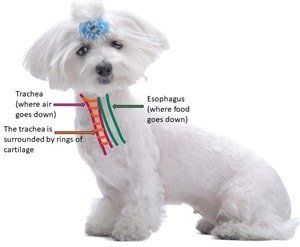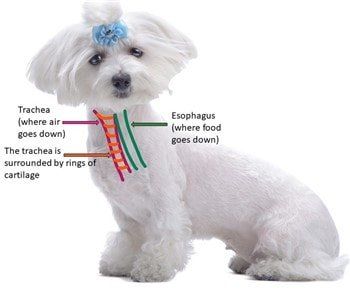Collars and Harnesses for Maltese Puppies and Dogs
Overview
When you have your Maltese puppy or dog on leash, there are only two basic accessory options: a harness or a collar. And of these two, it may seem like it’s down to a choice of which is cuter or is easier to put on. But, there is actually a lot more to this. In fact, your Maltese puppy or dog’s well-being may depend on it.
Please note:
PetMaltese is reader-supported. Some of the product suggestions on this page are affiliate links. As an Amazon Associate we earn from qualifying purchases. This is at no extra cost to you and helps us continue creating useful content.
The Anatomy of a Maltese’s Neck
Before we dive into collars and harnesses for Maltese, it’s important to understand about the anatomy of the neck, because, after all, that is where a collar sits.
A canine’s neck is similar to a human’s in the way that the throat divides into two canals. The trachea, also known as the windpipe, is the breathing tube through which air travels into the lungs. The esophagus is the passageway that food and water travel down into the stomach.
The tissue of the trachea is surrounded c-shaped rings of cartilage that hold the windpipe open. Dogs have varying numbers of trachea rings, often in the range of 35 to 45.
The rings, being made of cartilage, are much different from bone; they are relatively soft, which allows the neck to be flexible. While many medium and large-sized breeds also have thick neck muscles which protect the area, toy-sized breeds like the Maltese have very little protecting the neck.
And these two elements make the neck vulnerable to injury.
In addition to that, toy breeds like the Maltese are prone to a condition called collapsed trachea. This is what we’ll touch on next.
Collapsed Trachea and the Connection to Dog Collars
As the name implies, this is a condition in which ring(s) collapse. While this can happen to any breed, toy breeds like the Maltese are much more prone to this.
Dogs can be born with tracheal rings susceptible to weakening, which deteriorate over time. And, important to this topic, wearing a collar can accelerate this degeneration.
Once the signs of collapsed trachea are apparent (wheezing, a honking-like cough, exercise intolerance, and/or trouble eating) the damage has been done. There is no cure. Non-surgical treatment consists of immediate discontinuation of a collar, with a switch to a harness. Antibiotics, anti-inflammatory meds, and cough medication are given. Surgery, which is a last resort, is expensive and very risky.
Just the risk factor of collapsed trachea alone is a strong argument for throwing away dog collars and only using harnesses; however, next we’ll cover other problems linked to dog collars.
Other Issues Seen with Collars
Increased risk of neurological problems
– Due to restricted blood flow to the forelegs, malfunction of nerves can lead to lameness. Paw licking is often one of the first signs. Dog collars also put pressure on the spinal cord and vertebral discs.
Hypothyroidism
– Since the collar often sits directly on the thyroid gland, pulling on the leash while wearing a collar can cause inflammation which then triggers the immune system to overproduce antibodies, leading to hypothyroidism.
Eye issues
- It is thought that both glaucoma and certain cornea issues (weakened or thinned corneas) are linked to collars. A study by the Journal of the American Animal Hospital Association
shows this correlation.
Seizures
– This should be of particular interest because the Maltese breed is prone to seizures. And, while there are many causes, one is trauma of the C1 or C2 vertebrae. And this sort of trauma is seen at a higher rate
in dogs that pull against leashes while wearing a collar.
Summary Thus Far
With collapsed trachea, neurological problems, hypothyroidism, eye issues, and even seizures all linked to dog collars, it is clear that the best course of action is to never place your Maltese on leash and collar.
Fortunately, there is a great alternative and you’ll find that it has benefits that extend beyond avoiding serious health problems. This is what we will cover next.
Harnesses for Maltese Puppies and Dogs
A harness is the best accessory to place on your Maltese any time you have your little guy or gal on leash.
Unlike a collar, nothing touches the neck. Rather, pressure is distributed across the shoulders, chest, and back.
In fact, with your Maltese on a harness, should any danger occur (about to tumble down stairs, large dog approaching, etc.) you can quickly reel your Maltese to you or even lift him or her up without any pressure constricting the neck.
FAQ about Harnesses
Are these hard to put on?
There are different types of harness that you can place on your Maltese. Some slip over the head, and these are the trickiest to place on a puppy or dog and are not recommended unless your Maltese is already used to this via doggie clothing.
But, there are some fantastic ‘step in’ designs that make it super-easy to place on, literally taking just a matter of seconds.
Will a harness make my Maltese hot?
You may assume that a harness is similar to wearing a shirt, thereby making a dog hot in the summertime. However, some harnesses are made of mesh which allows air to pass through. Your Maltese can stay just as cool as he or she would otherwise.
Is it easier or harder to walk a dog with a harness?
It’s far easier. A harness offers you much more control. Each directional change you make with the leash guides a dog’s entire body, as opposed to just the neck if a dog were wearing a collar.
Will it be difficult for my Maltese to get used to a harness?
Though more breathable than a shirt, a harness is similar to slipping a little shirt on a puppy or dog. It’s not constricting in any way and many dogs love the attention that they get when looking extra-cute.
Though, like anything new, it can take a dog a few days to get used to a harness. However, we must put our dog’s well-being ahead of any initial fussiness.
Recommended Harnesses
When it comes to choosing a harness for your Maltese, there are a few factors to keep in mind. You’ll want it to be super comfortable, easy to place on and off, and durable.
These are our top recommendations:
1.
The Puppia Harness Soft B Vest .
.
This is a great little step-in harness, meaning that you just place your Maltese’s front paws in the leg holes. Then, a small Velcro flap on the back secures it in place. This is made of breathable air-mesh which lets the air pass through, keeping a dog nice in cool even when the temps are soaring.
It fits just about any dog, even tiny pups, with the extra-small a mere 7 and 3/4 inches for neck girth (right above the shoulders). While you should measure your Maltese with a soft-cloth tape, an easy way to get an idea is to take a sheet of regular letter-sized paper. The shorter end is 8.5 inches; so, make the ends touch and you’ll see just how small the extra-small is.
If you want to keep your little one looking stylish, this comes in 13 different colors. The O-ring hook for the leash is quite sturdy and the stitching is great, making this very durable as well.
2.
The Puppia RiteFit Adjustable Harness .
.
This is a top choice due to it being completely adjustable harness; you can adjust the sizing around the chest and around the belly. It is also made with breathable air mesh and is available in an array of 9 colors. This harness is extremely easy to place onto a Maltese as there are no leg holes, you just slip it over your dog and buckle it. And, it’s super-easy to take off via two quick release buckles.
This starts at size small, which is a neck measurement of 9.5” (right above the shoulders), so this is for older pups or adult Maltese.
3.
The Lil Pals Comfort Mesh Adjustable Step-in Harness .
.
If you are looking for a super lightweight harness that is also very easy to place on, and you have a young puppy or a Maltese on the smaller side, this is a great choice.
This is also a step-in, you just slip the two front paws through the leg hole and flip over the Velcro flap on the back. This accessory is designed specifically for petite dogs; the two sizes are extra-small (for dogs with a chest girth of 8 to 10 inches; typically, those under 5 lbs.) and small (for dogs with a chest girth of 10 to 12 inches).
As a bonus, these come in adorable multi-color designs to keep your Maltese looking snazzy.
A Final Word
With so many harness options for toy breeds that are comfortable and easy to place on, there is never a reason to every connect a leash to a Maltese’s collar. Doing so has no benefits and only increases the risk of neck injury and other collar-related concerns. Never look back on things in hindsight, wishing you had done something differently.
Spotlight Article
There are 5 steps to keep a Maltese ultra white, while maintaining excellent skin and coat health.

-min-450x169-1920w.jpg)






-min-180x187-1920w.jpg)